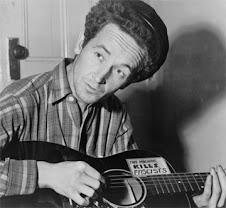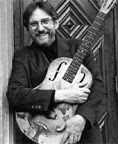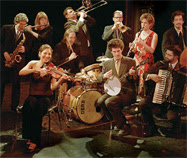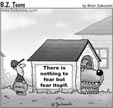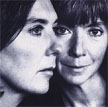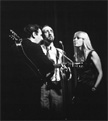This is a clip from the Concert/Film "The Big TNT Show"
which also features Ray Charles, Ike & Tina,
Donovan, The Lovin' Spoonful, The Ronettes and Man From UNCLE David MacCollum.
Some "skips" in the tape but if you stick with it, you will be glad.
in 1969 on Italian TV
This is a blog for the audience of WICN's The Folk Revival ~ 3 hours of the folk of the folk revivals of the 20th century into the 21st century. Hosted by Nick noble sharing some of his favorite roots and branches of folk music. Scroll down right column for interesting lists and information.
Saturday, September 22, 2007
Friday, September 21, 2007
Still singing and touring ~ Joan Baez
http://joanbaez.com/tourschedule07.html
But here she is in 1975
Joan Chandos Baez (born January 9, 1941) is an American folk singer and songwriter known for her highly individual vocal style. She is a soprano with a three-octave vocal range[1] and a distinctively rapid vibrato. Many of her songs are topical and deal with social issues.
She is best known for her 1970s hits "Diamonds & Rust" and "The Night They Drove Old Dixie Down" -- and to a lesser extent,"We Shall Overcome" "Sweet Sir Galahad" and "Joe Hill" (songs she performed at the 1969 Woodstock festival). She is also well known due to her early and long-lasting relationship with Bob Dylan and her even longer-lasting passion for activism, notably in the areas of nonviolence, civil and human rights and, in more recent years, the environment. She has performed publicly for nearly 50 years, released over 30 albums and recorded songs in over eight languages. She is considered a folksinger although her music has strayed from folk considerably after the 1960s, encompassing everything from rock and pop to country and gospel. Although a songwriter herself, especially in the mid-1970s, Baez is most often regarded as an interpreter of other people's work, covering songs by Bob Dylan, The Beatles, Jackson Browne, Paul Simon, The Rolling Stones, Stevie Wonder and myriad others. In more recent years, she has found success interpreting songs of diverse songwriters such as Steve Earle, Natalie Merchant and Ryan Adams.
in 1966
But here she is in 1975
Joan Chandos Baez (born January 9, 1941) is an American folk singer and songwriter known for her highly individual vocal style. She is a soprano with a three-octave vocal range[1] and a distinctively rapid vibrato. Many of her songs are topical and deal with social issues.
She is best known for her 1970s hits "Diamonds & Rust" and "The Night They Drove Old Dixie Down" -- and to a lesser extent,"We Shall Overcome" "Sweet Sir Galahad" and "Joe Hill" (songs she performed at the 1969 Woodstock festival). She is also well known due to her early and long-lasting relationship with Bob Dylan and her even longer-lasting passion for activism, notably in the areas of nonviolence, civil and human rights and, in more recent years, the environment. She has performed publicly for nearly 50 years, released over 30 albums and recorded songs in over eight languages. She is considered a folksinger although her music has strayed from folk considerably after the 1960s, encompassing everything from rock and pop to country and gospel. Although a songwriter herself, especially in the mid-1970s, Baez is most often regarded as an interpreter of other people's work, covering songs by Bob Dylan, The Beatles, Jackson Browne, Paul Simon, The Rolling Stones, Stevie Wonder and myriad others. In more recent years, she has found success interpreting songs of diverse songwriters such as Steve Earle, Natalie Merchant and Ryan Adams.
in 1966
Tuesday, September 18, 2007
The Phil Ochs FBI File
Folk Singer for the FBI: The Phil Ochs FBI File
by Federal Bureau of Investigation
Description: Hard to believe and who knows what they [FBI et alia] do these days.
Phil Ochs was one of the greatest political and topical folk singers of the 1960s. Ochs was first investigated by the Federal Bureau of Investigation (FBI) early on in his career, after writing a favorable article on Woody Guthrie in Mainstream magazine in 1963, which also brought another name to the attention of the FBI: Bob Dylan. The FBI attended political rallies where Ochs played, and he began noticing the attention, telling an audience in 1966: “I’m a folk singer for the FBI.” The FBI’s investigation intensified after the DNC riots in Chicago in August 1968. The FBI attempted to build a case against Ochs and other members of the Youth International Party (Yippies), but the indictment against Ochs never materialized due to a lack of evidence. Ochs instead later testified at the Chicago Seven trial for the defense. Despite the hundreds of pages in his FBI file, Ochs never committed a federal crime. He continued to be under investigation until his death by suicide in 1976.
by Federal Bureau of Investigation
Description: Hard to believe and who knows what they [FBI et alia] do these days.
Phil Ochs was one of the greatest political and topical folk singers of the 1960s. Ochs was first investigated by the Federal Bureau of Investigation (FBI) early on in his career, after writing a favorable article on Woody Guthrie in Mainstream magazine in 1963, which also brought another name to the attention of the FBI: Bob Dylan. The FBI attended political rallies where Ochs played, and he began noticing the attention, telling an audience in 1966: “I’m a folk singer for the FBI.” The FBI’s investigation intensified after the DNC riots in Chicago in August 1968. The FBI attempted to build a case against Ochs and other members of the Youth International Party (Yippies), but the indictment against Ochs never materialized due to a lack of evidence. Ochs instead later testified at the Chicago Seven trial for the defense. Despite the hundreds of pages in his FBI file, Ochs never committed a federal crime. He continued to be under investigation until his death by suicide in 1976.
Sunday, September 16, 2007
Phil Ochs on folk music - circa 1969

"Before the days of television and mass media, the folksinger was often a traveling newspaper spreading tales through music. There is an urgent need for Americans to look deeply into themselves and their actions, and musical poetry is perhaps the most effective mirror available. Every newspaper headline is a potential song."
- Phil Ochs
And Phil put this in his liner notes:
"A pamphlet, no matter how good, is never read more than once, but a song is learned by heart and repeated over and over." -- Joe Hill
Live music by Phil Ochs - keeping it real
History of Phil Ochs Song Nights from http://www.sonnyochs.com/
On April 9, 1976 my brother, Phil Ochs, ended his life by hanging himself. He was 35 years old. He had written over 100 songs, and had traveled to many countries. He suffered from manic-depression and had been experiencing a long term writer's block.
I had moved up to the Albany area in '86, so I decided to move the Song Night upstate so as not to have to travel to the city anymore. In 1987 the Song Night was held for the first time at the Eighth Step Coffeehouse on Nov. 6th, and it was held there every year until 1999 except once when there was a date mix-up, and it had to be held elsewhere in the Capitol District. That same year we did a Song Night in Philadelphia.
Up to this point all the Song Nights had the same formula. Each performer would sing one or two of Phil's songs, depending on how many they knew, and that was it. The philosophy behind Song Night was to keep Phil's music alive, to give all the monies collected to organizations in the folk field who were struggling financially, and to showcase performers. Money was given to groups like People's Music Network, Broadside Magazine, Sing Out Magazine, New Song Library, various non-profit folk clubs and college radio stations. I would appeal to the audience to go out and see the performers when they were in town doing their own material. I found it frustrating that people would pay money to hear Phil's songs, but not the songs of the performers. Sammy Walker said, "Phil Ochs draws a larger audience dead than we do alive."
A side benefit of the creation of the Song Night was that several performers liked the songs that I asked them to sing so much that they included them in their repertoires and sang them all around the country. The ultimate thrill was when Kim and Reggie Harris not only recorded "In the Heat of the Summer", they also made it the title song of their first cd.
After several years of only doing Phil's songs at the Song Nights I started to get bored hearing the same songs over and over by basically the same performers. We were playing in different venues including Washington DC and Cambridge, Massachusetts by this time so the audiences were different, but I needed a change. I decided to change to format so that each performer would do one of Phil's songs and one of his/her own, thus giving the audience a taste of what is being written today. As of now, this is still the formula we're using. I much prefer it, but some of the performers think we should only do Phil's songs, and that's what some of them do.
Another minor change was added when we did a show at the Village Gate in Manhattan in November of '93. There was a biography of Phil by Michael Schumacher being written at that time. He let us have some of his transcripts from several interviews. We had two excerpts read which described some of Phil's adventures in Africa and South America. They were quite humorous and added a new dimension to the Song Night. We have included this practice in several Song Nights since then.
So the Song Nights continue. Many performers have taken part in them, and many more will be invited in the future. Some of the regulars include Emma's Revolution (Pat Humphries & Sandy Apatow) , John Flynn, David Roth, Greg Greenway, Kim & Reggie Harris and Magpie. In 1994 we made our first foray into Canada, doing a show in Toronto, in 1996 we did a min-tour covering 8 cities in the mid west, and in 1999 we went to 7 cities in the mid west including a major tribute to Phil at the Rock and Roll Hall of Fame in Cleveland. We also did 2 nights at the Kennedy Center's Millennium Stage.
We toured the northwest in 2004, starting in Vancouver with shows in Washington and Oregon, ending up in California - San Francisco, Santa Cruz and Berkeley. It's really exciting to be a part of a constantly evolving show with the main purpose of keeping Phil Ochs' music out there.
On April 9, 1976 my brother, Phil Ochs, ended his life by hanging himself. He was 35 years old. He had written over 100 songs, and had traveled to many countries. He suffered from manic-depression and had been experiencing a long term writer's block.
I had moved up to the Albany area in '86, so I decided to move the Song Night upstate so as not to have to travel to the city anymore. In 1987 the Song Night was held for the first time at the Eighth Step Coffeehouse on Nov. 6th, and it was held there every year until 1999 except once when there was a date mix-up, and it had to be held elsewhere in the Capitol District. That same year we did a Song Night in Philadelphia.
Up to this point all the Song Nights had the same formula. Each performer would sing one or two of Phil's songs, depending on how many they knew, and that was it. The philosophy behind Song Night was to keep Phil's music alive, to give all the monies collected to organizations in the folk field who were struggling financially, and to showcase performers. Money was given to groups like People's Music Network, Broadside Magazine, Sing Out Magazine, New Song Library, various non-profit folk clubs and college radio stations. I would appeal to the audience to go out and see the performers when they were in town doing their own material. I found it frustrating that people would pay money to hear Phil's songs, but not the songs of the performers. Sammy Walker said, "Phil Ochs draws a larger audience dead than we do alive."
A side benefit of the creation of the Song Night was that several performers liked the songs that I asked them to sing so much that they included them in their repertoires and sang them all around the country. The ultimate thrill was when Kim and Reggie Harris not only recorded "In the Heat of the Summer", they also made it the title song of their first cd.
After several years of only doing Phil's songs at the Song Nights I started to get bored hearing the same songs over and over by basically the same performers. We were playing in different venues including Washington DC and Cambridge, Massachusetts by this time so the audiences were different, but I needed a change. I decided to change to format so that each performer would do one of Phil's songs and one of his/her own, thus giving the audience a taste of what is being written today. As of now, this is still the formula we're using. I much prefer it, but some of the performers think we should only do Phil's songs, and that's what some of them do.
Another minor change was added when we did a show at the Village Gate in Manhattan in November of '93. There was a biography of Phil by Michael Schumacher being written at that time. He let us have some of his transcripts from several interviews. We had two excerpts read which described some of Phil's adventures in Africa and South America. They were quite humorous and added a new dimension to the Song Night. We have included this practice in several Song Nights since then.
So the Song Nights continue. Many performers have taken part in them, and many more will be invited in the future. Some of the regulars include Emma's Revolution (Pat Humphries & Sandy Apatow) , John Flynn, David Roth, Greg Greenway, Kim & Reggie Harris and Magpie. In 1994 we made our first foray into Canada, doing a show in Toronto, in 1996 we did a min-tour covering 8 cities in the mid west, and in 1999 we went to 7 cities in the mid west including a major tribute to Phil at the Rock and Roll Hall of Fame in Cleveland. We also did 2 nights at the Kennedy Center's Millennium Stage.
We toured the northwest in 2004, starting in Vancouver with shows in Washington and Oregon, ending up in California - San Francisco, Santa Cruz and Berkeley. It's really exciting to be a part of a constantly evolving show with the main purpose of keeping Phil Ochs' music out there.
Saturday, September 15, 2007
Saturday, September 8, 2007
Big Bill Broozny
great video - from 1956
http://youtube.com/watch?v=KhPTfPykpDI
Born William Lee Conley Broonzy
June 26, 1893
Scott, MS.
Died
August 15, 1958
Chicago, IL.
Broonzy's body of work--including his enduring
originals "Key to the Highway" and "Black, Brown
and White"--ranks him among Muddy Waters, B.B.
King and Robert Johnson in terms of influence.
A storyteller as much as a lonesome singer, Broonzy was
among the first performers to marry rough rural blues (like
Johnson's brand of Mississippi Delta moaning) with upscale jazzy
city blues (like Charles Brown's cocktail piano crooning). He began
his career as a violinist (a skill he learned from an uncle) and learned
from mentor Papa Charlie Jackson how to adapt those skills to the guitar.
As his obvious talent gradually turned him into a star, he moved to Chicago
and started hooking up with Memphis Slim, Brownie McGhee, John Lee "Son-
ny Boy" Williamson and Big Maceo; he also recorded for many different
labels, including Columbia, OKeh and Bluebird. Most refused to put
out "Black, Brown and White"--a powerful attack on racism with
the memorable tell-it-like-it-is chorus, "Get back," after
Broonzy wrote it in 1949; two years later, in France,
writer-critic Hugues Panassie and record company
officials helped him get it in circulation.
Broonzy's pockets of regional popularity coagulated into an adoring
national audience after he played John Hammond's From Spirituals to Swing
concert (as a replacement for Robert Johnson, who had just died) at New York
City's Carnegie Hall in 1938. Regular Chicago and southern gigs followed until
the 1950s, when Broonzy--along with peers Leadbelly, Josh White and Sonny Terry
and Brownie McGhee--became an avatar of the folk movement. While touring and
recording in Europe throughout the 1950s, he wrote a fascinating biography,
Big Bill Blues, with Danish writer Yannick Bruynoghe.
Because Broonzy was such a prolific writer and because so many different
big record companies put out his stuff, plenty of thorough CD collections doc-
ument various stages of his career. Most impressive include Good Time Tonight
(Columbia/Legacy, 1990, prod. various) [Rating: 5.0] , which spans 1930 to
1940 (including, of course, his classic "I Can't Be Satisfied");
Do That Guitar Rag (1928-35) (Yazoo, 1973) [Rating: 4.5] ; and Blues in the
Mississippi Night (Rykodisc, 1990) [Rating: 5.0] , a sometimes chilling 1946 Alan
Lomax-recorded no-holds-barred conversation between Broonzy, pianist Memphis
Slim and harpist Sonny Boy Williamson about racism in the South.
What to Buy Next:
Feelin' Low Down (GNP Crescendo, 1973) [Rating: 3.5]
Worth Searching For:
Big Bill's Blues (Portrait) [Rating: 5.0] captures Broonzy's
seriousness and humor as well as the spontaneity of his record-
ing process.
From:
MusicHound Blues:
The Essential Album Guide
By Steve Knopper
Copyright © 1998 Visible Ink Press
A division of Gale Research
http://youtube.com/watch?v=KhPTfPykpDI
Born William Lee Conley Broonzy
June 26, 1893
Scott, MS.
Died
August 15, 1958
Chicago, IL.
Broonzy's body of work--including his enduring
originals "Key to the Highway" and "Black, Brown
and White"--ranks him among Muddy Waters, B.B.
King and Robert Johnson in terms of influence.
A storyteller as much as a lonesome singer, Broonzy was
among the first performers to marry rough rural blues (like
Johnson's brand of Mississippi Delta moaning) with upscale jazzy
city blues (like Charles Brown's cocktail piano crooning). He began
his career as a violinist (a skill he learned from an uncle) and learned
from mentor Papa Charlie Jackson how to adapt those skills to the guitar.
As his obvious talent gradually turned him into a star, he moved to Chicago
and started hooking up with Memphis Slim, Brownie McGhee, John Lee "Son-
ny Boy" Williamson and Big Maceo; he also recorded for many different
labels, including Columbia, OKeh and Bluebird. Most refused to put
out "Black, Brown and White"--a powerful attack on racism with
the memorable tell-it-like-it-is chorus, "Get back," after
Broonzy wrote it in 1949; two years later, in France,
writer-critic Hugues Panassie and record company
officials helped him get it in circulation.
Broonzy's pockets of regional popularity coagulated into an adoring
national audience after he played John Hammond's From Spirituals to Swing
concert (as a replacement for Robert Johnson, who had just died) at New York
City's Carnegie Hall in 1938. Regular Chicago and southern gigs followed until
the 1950s, when Broonzy--along with peers Leadbelly, Josh White and Sonny Terry
and Brownie McGhee--became an avatar of the folk movement. While touring and
recording in Europe throughout the 1950s, he wrote a fascinating biography,
Big Bill Blues, with Danish writer Yannick Bruynoghe.
Because Broonzy was such a prolific writer and because so many different
big record companies put out his stuff, plenty of thorough CD collections doc-
ument various stages of his career. Most impressive include Good Time Tonight
(Columbia/Legacy, 1990, prod. various) [Rating: 5.0] , which spans 1930 to
1940 (including, of course, his classic "I Can't Be Satisfied");
Do That Guitar Rag (1928-35) (Yazoo, 1973) [Rating: 4.5] ; and Blues in the
Mississippi Night (Rykodisc, 1990) [Rating: 5.0] , a sometimes chilling 1946 Alan
Lomax-recorded no-holds-barred conversation between Broonzy, pianist Memphis
Slim and harpist Sonny Boy Williamson about racism in the South.
What to Buy Next:
Feelin' Low Down (GNP Crescendo, 1973) [Rating: 3.5]
Worth Searching For:
Big Bill's Blues (Portrait) [Rating: 5.0] captures Broonzy's
seriousness and humor as well as the spontaneity of his record-
ing process.
From:
MusicHound Blues:
The Essential Album Guide
By Steve Knopper
Copyright © 1998 Visible Ink Press
A division of Gale Research
Saturday, September 1, 2007
History of Sing Out! from 2000 interview http://www.wjffradio.org
Folk Plus - Saturday March 4, 2000
Telephone interview with Mark Moss, editor of Sing Out! Folk Song Magazine.
Mark Moss talks about Sing Out! before the 3/4/2000 airing of Folk Plus on WJFF, featuring the music reviewed in the current Winter 2000 issue of the magazine.
Angela: This is Mark Moss, editor of Sing Out! and thanks for joining us and kicking off this show. I'd love it if you could give a basic intro to the history of Sing Out!...
Mark: Sure. Well, Sing Out!'s story started actually a few years before Sing Out! did. In 1946 at the close of the Second World War, when a group of folks were coming back from serving in the various branches of the armed service (these included Pete Seeger, Woody Guthrie and that era of folkies) they wanted a way to keep in touch with each other when going their separate ways all across the country. So, they started an organization called "People's Songs", which was an arts cooperative along with Pete, Woody, Paul Robeson, Lena Horne, Carl Reiner and tons of people from all parts of the entertainment field. They also published a monthly newsletter called "People's Songs" which was a way of keeping in touch with each other and publishing traditional songs, political songs, labor songs, to share with the work they were doing. It evolved into a cooperatively run booking organization that if you needed a singer to come and be in a rally or something like that you'd call "People's Songs" and you'd get Pete, or Woody or Sonny Terry, or one of the hundreds of artists that participated in the group.
In 1949 "People's Songs", coming off the heels of work that they had done on the Wallace campaign in 1948 (Henry Wallace was the socialist candidate that year) and "People's Songs" had put a whole bunch of work into trying to help him get elected and were essentially bankrupt at the close of the election. By the time the next year rolled around, they were done. By December of 1949 they published the final issue of "People's Songs". But the membership that was somewhere between six hundred and a thousand people at that point said "Hey, wait a minute, we really want this magazine. This way to share songs, keep in touch and link/bridge for the community." So People's Artists, which is what the organization evolved into after the bankrupcy, May of 1950, published the first issue of a little magazine called Sing Out! which derived its name from the lyrics to a song by Pete Seeger and Lee Hays, two members of the Weavers called "Hammer Song" which 10 or 12 years later became a big hit for Peter Paul and Mary as "If I Had a Hammer". So that's really where Sing Out! came from.
As the 50's involved into the 60's with the folk boom or folk scare however you want refer to it, took over. Sing Out! rode that crest along with it and grew to have a circulation/readership of pretty close to 20,000 in it hey day. By the late 70's the editor of the magazine since just about its inception, a fellow by the name of Irwine Silver, decided he wanted to move on and do other things and sold the magazine to a cooperative of folks which included Mose Ashe of Folkway Records. There have been a long standing symbiotic relationship between Folkways and Sing Out! Happy Traum, Harold Leventhal, Manny Soloman from Vangaard Records, a whole group of people who were involved in the late 60's folk era. That group of people then passed the ownership of the magazine on to itself. They saw it as buying out Irwin and giving a magazine a way to continue on its own.
All these years, right through, cause Sing Out! never stopped publishing during these transitions, they always published lots of songs, running the gammit. I mean I heard the distance sort of, the intro to your show, and like you say, the definition of what folk music is, is extremely broad. Along with Child Ballads and traditional Appalachian Mountain tunes, Cajun music, bluegrass and blues and a lot of stuff that's easier to put under the folk umbrella. They also printed music from all around the world before there was a way to explain traditional music from other cultures as World Music. Before that nomanclature was there, Sing Out! was including that under the umbrella of what folk music was. Starting in 1950 they had an "international music" section to the magazine. Ian Anderson, who is the editor of Folk Roots, one of our sister publications, published out of England, says that the first time he ever heard African Music was on a little flexible plastic record that was included in an issue of Sing Out! magazine in the 1970's. Ian was one of the folks who actually got together and created the "World Music" slot for marketing African and Middle Eastern Music into record stores in Great Britain. So, that has always been what our mission was.
By the late 1970's early 1980's Sing Out! was having another fiscal crisis, very similar to what had occurred in 1949. This time, Pete was still involved in the magazine we had the benefit of him really having lived through the history of what had gone on before, Pete came to a group of us who were involved in the magazine and said "Look you can't just pack it in. We have to go to the readership of the magazine and say 'What do you wnat us to do' because maybe we can find a way to save this?" So for about 3 or 4 months, Pete and I co-edited a newsletter that went out to the approximately 2,000 members that were still readers subscribing to Sing Out! at that time.
Angela: What year was that?
Mark: That was 1982. We said "What would you like us to do? Is this important to you? Would you like us to keep it going?" Resoundingly, both with their voices and their wallets, they spoke and helped us pay off a sizeable back debt. We moved the operation to Pennsylvania, formed a non-profit tax-exempt corporation and started publishing in Pennsylvania in April of 1983. It has taken off since then. Today our readership is approaching the peak that Sing Out! had in the 1960's during the folk boom. We have a circulation of approaching 20,000 about a third of which are members of the organization and get every issue mailed to their house. Today we are quarterly. The magazine is a lot bigger than it used to be. Each issue is more than 200 pages. We have 6 feature articles in each issue. Columns from all kinds of folks, including Pete, who still writes a regular column for us, instrumental teach-ins.... I think the most important aspect of what Sing Out! does and what really sets us apart from other music magazines is that we publish 20 songs in each issue of the magazine with full lead sheets and lyrics for people to learn. I guess our fundamental 'raison d'etre" our mission statement for what we do as a non-profit is, that we want people to not just consume music but to make music. Have it be part of their daily lives. Sing a lullabye to your kid when you are putting him or her to sleep, get friends in together and make music in your kitchen or living room. Along with publishing Sing Out!, about 10 years ago we started a book publishing arm of the organization. The first book we put out was a book called "Rise up Singing" which was become enormously popular among group singing circles and people who like to make music in their homes. We sold nearly 3/4 of a million copies of that book.
Angela: Its a bible.
Mark: Yeah, a lot of people call it the blue bible. We also maintain a multi-media archive and resource centre of recordings and photos and newspaper clippings and books and magazines and anything related to the folk revival from the 1940's to the present in our offices here in Pennsylvania. We are working diligently to try to make more of it accessable through our website.
Angela: It is endless work. It's endless!
Mark: Yeah. But you know it beats digging ditches.
Angela: Well if people listening for the next two hours Mark, really have their interest peaked - never heard of Sing Out! before and don't get a copy, I was going to tell them the website.
Mark: www.Singout.org
Angela: Is there a toll free number also I believe.
Mark: There is, 888 SINGOUT. One of the new toll free exchanges. If you go to the website people will notice that there is a link right there to get a free sample issue of the magazine if they'd like to try it out.
Telephone interview with Mark Moss, editor of Sing Out! Folk Song Magazine.
Mark Moss talks about Sing Out! before the 3/4/2000 airing of Folk Plus on WJFF, featuring the music reviewed in the current Winter 2000 issue of the magazine.
Angela: This is Mark Moss, editor of Sing Out! and thanks for joining us and kicking off this show. I'd love it if you could give a basic intro to the history of Sing Out!...
Mark: Sure. Well, Sing Out!'s story started actually a few years before Sing Out! did. In 1946 at the close of the Second World War, when a group of folks were coming back from serving in the various branches of the armed service (these included Pete Seeger, Woody Guthrie and that era of folkies) they wanted a way to keep in touch with each other when going their separate ways all across the country. So, they started an organization called "People's Songs", which was an arts cooperative along with Pete, Woody, Paul Robeson, Lena Horne, Carl Reiner and tons of people from all parts of the entertainment field. They also published a monthly newsletter called "People's Songs" which was a way of keeping in touch with each other and publishing traditional songs, political songs, labor songs, to share with the work they were doing. It evolved into a cooperatively run booking organization that if you needed a singer to come and be in a rally or something like that you'd call "People's Songs" and you'd get Pete, or Woody or Sonny Terry, or one of the hundreds of artists that participated in the group.
In 1949 "People's Songs", coming off the heels of work that they had done on the Wallace campaign in 1948 (Henry Wallace was the socialist candidate that year) and "People's Songs" had put a whole bunch of work into trying to help him get elected and were essentially bankrupt at the close of the election. By the time the next year rolled around, they were done. By December of 1949 they published the final issue of "People's Songs". But the membership that was somewhere between six hundred and a thousand people at that point said "Hey, wait a minute, we really want this magazine. This way to share songs, keep in touch and link/bridge for the community." So People's Artists, which is what the organization evolved into after the bankrupcy, May of 1950, published the first issue of a little magazine called Sing Out! which derived its name from the lyrics to a song by Pete Seeger and Lee Hays, two members of the Weavers called "Hammer Song" which 10 or 12 years later became a big hit for Peter Paul and Mary as "If I Had a Hammer". So that's really where Sing Out! came from.
As the 50's involved into the 60's with the folk boom or folk scare however you want refer to it, took over. Sing Out! rode that crest along with it and grew to have a circulation/readership of pretty close to 20,000 in it hey day. By the late 70's the editor of the magazine since just about its inception, a fellow by the name of Irwine Silver, decided he wanted to move on and do other things and sold the magazine to a cooperative of folks which included Mose Ashe of Folkway Records. There have been a long standing symbiotic relationship between Folkways and Sing Out! Happy Traum, Harold Leventhal, Manny Soloman from Vangaard Records, a whole group of people who were involved in the late 60's folk era. That group of people then passed the ownership of the magazine on to itself. They saw it as buying out Irwin and giving a magazine a way to continue on its own.
All these years, right through, cause Sing Out! never stopped publishing during these transitions, they always published lots of songs, running the gammit. I mean I heard the distance sort of, the intro to your show, and like you say, the definition of what folk music is, is extremely broad. Along with Child Ballads and traditional Appalachian Mountain tunes, Cajun music, bluegrass and blues and a lot of stuff that's easier to put under the folk umbrella. They also printed music from all around the world before there was a way to explain traditional music from other cultures as World Music. Before that nomanclature was there, Sing Out! was including that under the umbrella of what folk music was. Starting in 1950 they had an "international music" section to the magazine. Ian Anderson, who is the editor of Folk Roots, one of our sister publications, published out of England, says that the first time he ever heard African Music was on a little flexible plastic record that was included in an issue of Sing Out! magazine in the 1970's. Ian was one of the folks who actually got together and created the "World Music" slot for marketing African and Middle Eastern Music into record stores in Great Britain. So, that has always been what our mission was.
By the late 1970's early 1980's Sing Out! was having another fiscal crisis, very similar to what had occurred in 1949. This time, Pete was still involved in the magazine we had the benefit of him really having lived through the history of what had gone on before, Pete came to a group of us who were involved in the magazine and said "Look you can't just pack it in. We have to go to the readership of the magazine and say 'What do you wnat us to do' because maybe we can find a way to save this?" So for about 3 or 4 months, Pete and I co-edited a newsletter that went out to the approximately 2,000 members that were still readers subscribing to Sing Out! at that time.
Angela: What year was that?
Mark: That was 1982. We said "What would you like us to do? Is this important to you? Would you like us to keep it going?" Resoundingly, both with their voices and their wallets, they spoke and helped us pay off a sizeable back debt. We moved the operation to Pennsylvania, formed a non-profit tax-exempt corporation and started publishing in Pennsylvania in April of 1983. It has taken off since then. Today our readership is approaching the peak that Sing Out! had in the 1960's during the folk boom. We have a circulation of approaching 20,000 about a third of which are members of the organization and get every issue mailed to their house. Today we are quarterly. The magazine is a lot bigger than it used to be. Each issue is more than 200 pages. We have 6 feature articles in each issue. Columns from all kinds of folks, including Pete, who still writes a regular column for us, instrumental teach-ins.... I think the most important aspect of what Sing Out! does and what really sets us apart from other music magazines is that we publish 20 songs in each issue of the magazine with full lead sheets and lyrics for people to learn. I guess our fundamental 'raison d'etre" our mission statement for what we do as a non-profit is, that we want people to not just consume music but to make music. Have it be part of their daily lives. Sing a lullabye to your kid when you are putting him or her to sleep, get friends in together and make music in your kitchen or living room. Along with publishing Sing Out!, about 10 years ago we started a book publishing arm of the organization. The first book we put out was a book called "Rise up Singing" which was become enormously popular among group singing circles and people who like to make music in their homes. We sold nearly 3/4 of a million copies of that book.
Angela: Its a bible.
Mark: Yeah, a lot of people call it the blue bible. We also maintain a multi-media archive and resource centre of recordings and photos and newspaper clippings and books and magazines and anything related to the folk revival from the 1940's to the present in our offices here in Pennsylvania. We are working diligently to try to make more of it accessable through our website.
Angela: It is endless work. It's endless!
Mark: Yeah. But you know it beats digging ditches.
Angela: Well if people listening for the next two hours Mark, really have their interest peaked - never heard of Sing Out! before and don't get a copy, I was going to tell them the website.
Mark: www.Singout.org
Angela: Is there a toll free number also I believe.
Mark: There is, 888 SINGOUT. One of the new toll free exchanges. If you go to the website people will notice that there is a link right there to get a free sample issue of the magazine if they'd like to try it out.
Subscribe to:
Posts (Atom)




